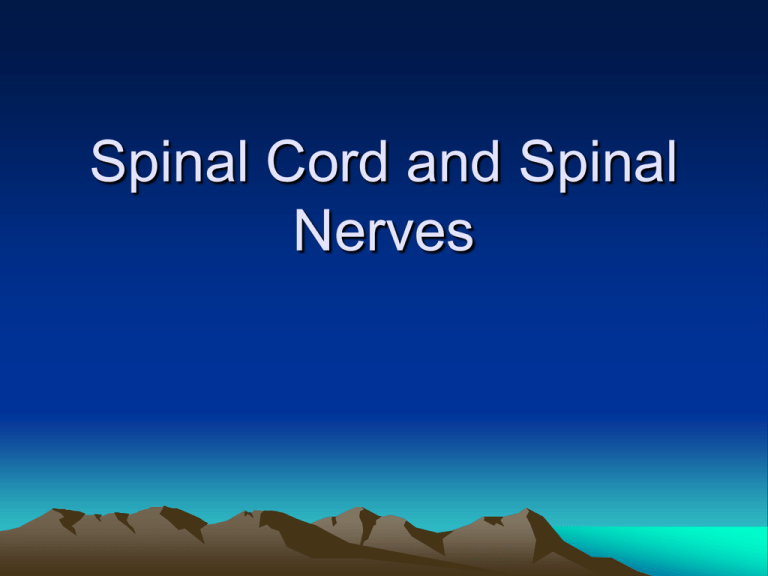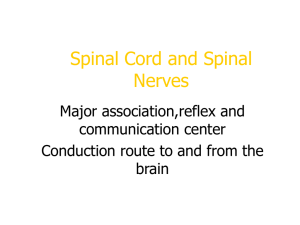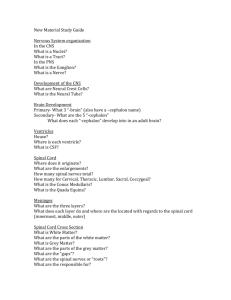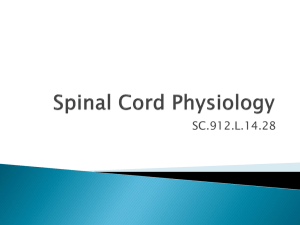Lecture 13-213.ppt
advertisement

Spinal Cord and Spinal Nerves Spinal Cord • Enclosed in the vertebral canal, extends from the foramen magnum of the skull to the first or second lumbar vertebra where it terminates in the cone shaped conus medullaris Spinal Cord • Spinal meninges; Dura Mater – outer Arachnoid Mater – middle Pia Mater – inner Spinal Cord • Dura Mater – composed of dense, irregular connective tissue Spinal Cord • Arachnoid Mater – It is an avascular covering with a spider’s web arrangement of delicate collagen fibers and some elastic fibers Spinal Cord • Pia Mater – A vascular and thin transparent connective tissue layer composed of interlacing bundles of collagen fibers and some fine elastic fibers Spinal Cord • Subarachnoid space – between the arachnoid mater and pia mater which contains cerebrospinal fluid Spinal Cord The dura mater and arachnoid meningeal coverings extend beyond the conus medullaris, approximately to the level of S2 Spinal Cord • Filium terminale – a fibrous extension of the pia mater, extends farther and attaches to the posterior coccyx Spinal Cord • 31 pairs of spinal nerves, which exit via the intervertebral foramina Spinal Cord • Since the spinal cord doesn’t extend to the end of the vertebral column, the spinal nerves emerging from the inferior end must travel through the vertebral canal until reaching the appropriate intervertebral foramina Spinal Cord • This collection of spinal nerves are called the cauda equina Spinal Cord / Gray Matter • Looks like an H Spinal Cord / Gray Matter • Posterior or dorsal horns – posterior projections Spinal Cord / Gray Matter • Anterior or ventral horns – anterior projections that contain cell bodies of motor neurons Spinal Cord / Gray Matter • Lateral Horns – In the thoracic and lumbar regions there is a lateral outpocketing of gray matter Spinal Cord / Gray Matter • Gray commissure – central area of gray matter Spinal Cord / Gray Matter • Dorsal root – Sensory fibers enter the cord here Spinal Cord / Gray Matter • Dorsal Root Ganglia – Cell bodies of sensory neurons located here Spinal Cord / Gray Matter • Ventral Roots – Motor neurons leave the cord here Spinal Cord / Gray Matter • Spinal nerves – are formed from the fusion of the dorsal and ventral roots Spinal Cord / Gray Matter Spinal Nerves; 8 pairs of cervical nerves 12 pairs of thoracic nerves 5 pairs of lumbar nerves 5 pairs of sacral nerves 1 pair of coccygeal nerves Spinal Cord / White Matter • The anterior median fissure and the posterior median sulcus divide the spinal cord into R. and L. sides Spinal Cord / White Matter • White matter is divided into columns; Posterior Funiculus, Anterior Funiculus, and Lateral Funiculus Spinal Cord / White Matter • Each column contains distinct bundles of nerve axons called tracts Spinal Cord / White Matter Two Types of Tracts 1. Sensory (ascending) tracts – conduct nerve impulses toward the brain Spinal Cord / White Matter 2. Motor (descending) tracts – conduct impulses down the cord Connective Tissue Coverings of Spinal Nerves • A fiber is a single axon within an endoneurium Connective Tissue Coverings of Spinal Nerves • A fascicle is a bundle of fibers within a perineurium Connective Tissue Coverings of Spinal Nerves • A nerve is a bundle of fascicles within an epineurium Spinal Nerves and Nerve Plexus • Each nerve divides into dorsal and ventral rami Spinal Nerves and Nerve Plexus • Rami contains both motor and sensory rami Spinal Nerves and Nerve Plexus • Dorsal rami – serve the skin and musculture of the posterior body trunk at their approximate level of emergence Spinal Nerves and Nerve Plexus • Ventral rami of spinal nerves T2 –T12 – pass anteriorly to supply the muscles of intercostal spaces, and the skin and muscles of the anterior and lateral trunk Spinal Nerves and Nerve Plexus • Ventral rami of all other nerves – form complex networks of nerves called plexuses Spinal Nerves and Nerve Plexus • The plexuses diverge again to form peripheral nerves Spinal Nerves and Nerve Plexus Four Plexuses 1. Cervical 2. Brachial 3. Lumbar 4. Sacral Spinal Nerves and Nerve Plexus 1. Cervical Plexus Supplies the skin and muscles of the head, neck, and upper part of the shoulders and diaphragm Spinal Nerves and Nerve Plexus • Damage to the spinal cord above the origin of the phrenic nerves causes respiratory arrest. Spinal Nerves and Nerve Plexus • Breathing stops because the phrenic nerves stops sending impulses to the diaphragm Spinal Nerves and Nerve Plexus 2. Brachial Plexus Supplies the upper extremities and a number of neck and shoulder muscles Spinal Nerves and Nerve Plexus • In carpal tunnel syndrome there is damage to the median nerve Spinal Nerves and Nerve Plexus 3. Lumbar Plexus Supplies the anterolateral abdominal wall, external genitals, and part of the lower extremities Spinal Nerves and Nerve Plexus • Femoral Nerve - Largest nerve arising from the lumbar plexus Spinal Nerves and Nerve Plexus 4. Sacral Plexus Supplies the buttocks and part of the lower extremities Spinal Nerves and Nerve Plexus • Sciatic Nerve – Largest nerve arising form the sacral plexus Spinal Nerves and Nerve Plexus • Sciatica – Pain that extends from the buttock down the back of the leg due to injury to the sciatic nerve Spinal Cord Physiology • The white matter tracts are highways for nerve impulse conduction to and from the brain Spinal Cord Physiology • The gray matter receives and integrates incoming and outgoing information Spinal Cord Physiology / Sensory Tracts Sensory information from receptors travels up the spinal cord via the; 1. Spinothalamic tracts 2. Posterior column tract Spinal Cord Physiology / Sensory Tracts Spinothalamic tracts carry pain, touch, and temperature impulses Spinal Cord Physiology / Sensory Tracts Posterior columns carry proprioception and vibration Spinal Cord Physiology / Motor Tracts Motor info. travels from the brain down the spinal cord to muscles and glands via the; 1. Pyramidal tracts 2. Extrapyramidal tracts Spinal Cord Physiology / Motor Tracts Pyramidal tracts control voluntary, purposeful motor movement of eyes, mouth, face, arms, and legs Spinal Cord Physiology / Motor Tracts Extrapyramidal tracts control more complex things like the accessory adjustments we make to muscle tone to adjust our posture Spinal Cord Physiology / Reflexes • The gray matter of the spinal cord serves as an integrating center for spinal reflexes Spinal Cord Physiology / Reflexes • A reflex is a fast, predictable, automatic response to changes in the environment that helps to maintain homeostasis Spinal Cord Physiology / Reflex Arc Five functional components; 1. Receptor 2. Sensory Neuron 3. Motor Neuron 4. Integrating Center Neuron 5. Effector Stretch Reflex 1. Slight stretching of a muscle stimulates sensory receptors in the muscle called muscle spindles Stretch Reflex 2. In response to being stretched the muscle spindle generates a nerve impulse along a somatic sensory neuron and enters the spinal cord via the posterior root Stretch Reflex 3. In the integrating center of the spinal cord the sensory neuron makes an excitatory synapse with a motor neuron in the anterior gray horn Stretch Reflex 4. If the excitation is strong enough a nerve impulse is propagated along the motor neuron which extends from the spinal cord to the muscle Stretch Reflex 5. ACh is released at the NMJ which triggers a muscle action potential in the stretched muscle (effector) and the muscle contracts




